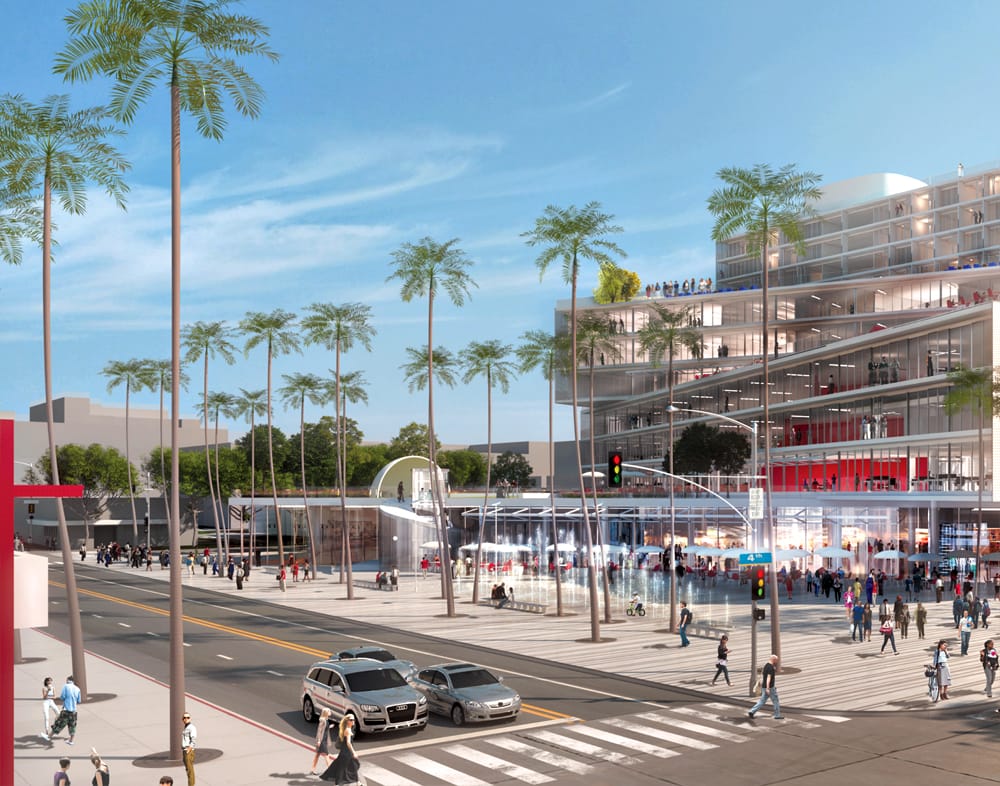
CITY HALL — A team led by Metropolitan Pacific Capital won approval from a selection committee to take its proposal to develop the city-owned site at Fifth Street and Arizona Avenue to the City Council in August, beating out two other competitors in the process.
Metropolitan Pacific Capital — in partnership with DLJ Real Estate Capital Partners and Clarett West Developers — offered the most compelling design, highest number of publicly available parking spaces and a satisfactory community outreach process, according to a city staff report.
The recommendation will go before the City Council on Aug. 27, at which point the council members will decided whether or not to enter into exclusive negotiations with the development team. If approved, a development agreement could be initiated as soon as the beginning of 2014, said Sarah Johnson, principal administrative analyst with the Department of Housing and Economic Development.
"We were thrilled to be identified as the preferred project," said John Warfel, principal with Metropolitan Pacific Capital. "We're really looking forward to being a part of this."
The Plaza at Santa Monica — designed by the Office of Metropolitan Architecture and local architect Johannes Van Tilburg of Van Tilburg, Banvard & Soderbergh — reaches 148 feet over 12 stories and a total of 424,000 square feet. As proposed, it will include a 225-room boutique hotel, restaurants, shops and a marketplace as well as cultural areas for both children and adults. Of the 1,220 parking spots, 580 would be open to the public.
An outdoor plaza transforms from dry basin for concerts or presentations to a small water feature in the summer and the much-beloved ice skating rink in the winter, which is a regular feature at the site.
The building rises up with each of the sections slightly askew from the one before it, creating space for outdoor parklets and open space at each level. The hotel caps the affair, and the team produced letters of interest from a number of hotel operators willing to set up in Santa Monica.
A ground-level public plaza would open to the corner at Fourth Street and Arizona Avenue, and the Biederman Redevelopment Ventures firm would create the team to manage the open space and fill it with markets, performances and activities to draw in the public.
It would represent roughly $330 million worth of investment, with a ground lease of $1.3 million each year to be paid to City Hall, according to a report by the Housing and Economic Development Department.
The partnership with City Hall gives the development team greater flexibility in design and use than might be allowed by the open market, like the open space, public parking and possible cultural component, Warfel said.
"It allows the project to contain more than just one or two specific market-driven uses," he said. "That's really the opportunity that we saw. It's an opportunity to do a truly mixed-use project."
The Plaza at Santa Monica beat out two competing proposals, one by Forest City Development and a second by Related California, the development team building The Village housing project near City Hall.
Forest City Development offered a ground-level plaza that opened to Fourth Street, and the lowest quantity of public parking. Panelists found it difficult to judge because the proposal was less developed than the other two, and they questioned the architectural design.
Related California offered the most "aggressive" design in terms of both height and density, although it also included the most affordable housing and partnered with Community Corporation of Santa Monica, the city's biggest developer of such housing. It also offered the most upfront ground rent — $33.2 million.
The Plaza at Santa Monica had the widest variety of businesses and entities included, and connected well to the Downtown, according to the report.
Unlike the other two, the proposal does not include affordable housing, although the team indicated that it would be willing to work it into the plan. It may also be possible to bring down the height, Warfel said.
"This is a proposed building and there's going to be a lot of input," he said.
The site is one of eight so-called "opportunity sites" in the Downtown Specific Plan, areas that officials have put forward for additional height and density than other areas of Downtown.
The Planning Department offered a 135-foot height limit for opportunity sites to be studied under an environmental document for that plan, which the proposal would top by 13 feet.
The City Council will take up the height issue on Aug. 13. If it approves the 135-foot limit, any development that goes above would have to request an amendment to the Downtown Specific Plan and complete it own environmental impact document, an expensive affair.
Both the City Council's decision and the following community process will help shape the overall height and features of the development, Warfel said.
"If we are over some arbitrary height limit by a few feet, obviously if it's not something that's desired, we will certainly look at staying within the limit," Warfel said.
ashley@www.smdp.com

